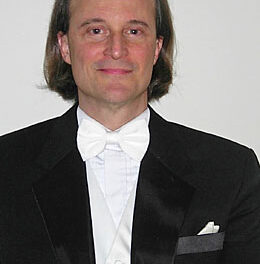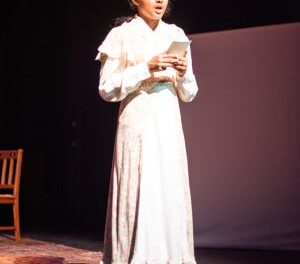Thematic programming is one of the many pleasures of Raleigh Civic Chamber Orchestra (RCCO) concerts. On Sunday, November 5, 2017, conductor Peter Askim led the RCCO in a program titled Pastorales: Music Inspired by Landscape and the Countryside. The concert, held in N.C. State University’s Stewart Theatre, included short pieces by a mid-20th century maverick, a commissioned world premiere, and a core classic from the early 19th century.
Dr. John Morillo, from NCSU’s English Department, gave an introductory survey of pastoral literature, explaining that most early writers, including Theocritus and Virgil, idealized shepherds and country folk, envisioning their lives as easy-going and carefree, in which songs and music-making figured prominently.
The program’s first section certainly fit with the notion of soothing communion with nature. American composer Lou Harrison (1917-2003) began writing his Seven Pastorales in 1947, completing them in 1952 while teaching at North Carolina’s Black Mountain College. These contemplative miniatures reflect his first experiments with alternative tunings and Asian musical styles, which soon became his signature composition mode.
Askim presented four of the seven Pastorales, beginning with one that Harrison dedicated to fellow composer John Cage (the order was incorrect in the program). The piece began without the conductor at the podium and the orchestra at rest. Mysteriously, two flutes began playing off stage in an interweaving of melodic lines, accompanied by two violins in drone fashion. The ethereal mood was hypnotic, the music seemingly in perpetual motion.
After the four players joined the others on stage, Askin mounted the podium for the second selection, dedicated to writer/choreographer Remy Charlip, a collaborator with Harrison on various projects. Its sunny, meanderings came in warm waves, enhanced by short instrumental solos. The third piece, honoring Harrison’s friends Ellie and David Decker on their marriage, had an autumnal richness and a feeling of open spaces. The last selection, also dedicated to Remy Charlip, evoked the hushed atmosphere of a lullaby in its gentle, swaying melody. Askim communicated the minimalist delicacy of each piece, the moods beautifully reflected in the playing.
If these lovely, introspective works made anyone think the rest of the concert would be similarly relaxed, it was quickly countered by the next piece on the program. Boston-based composer Delvyn Case (b. 1974) was commissioned to write a work in keeping with the concert’s theme (Askim programs a new work for each Civic Chamber Orchestra concert). Case was on hand for the premiere of his Pneumenon, speaking briefly about it beforehand. Although not specifically pastoral, the piece came to him while walking in the woods, contemplating how humans respond spiritually and physically to nature and music. He was particularly struck by the way musicians breathe life into their instruments and communicate with their whole bodies while playing.
After a cacophonous opening, with brass blaring and percussion ablaze, Pneumenon offered a series of alternating short sections, sometimes ominous, sometimes airy. Layers of rhythms built to intensity, then subsided into mystical quiet. Over the course of the 15-minute work, Case had the musicians make sounds with their hands, feet and breaths. The most arresting was a low hissing that suddenly emerged through the music, later turning into multiple whispers of “ha” and “hey.” One section had the string players stomping their feet and slapping their knees in syncopation; another had them thumping their breastbones.
Askim led a confident reading, the musicians intently concentrating on their tricky extra duties but managing admirably. The piece held attention aurally and visually because of the “playing” of the musicians’ bodies. There also was an array of unusual percussion accents, including a piano’s strings being plucked and slapped.
Beethoven’s Symphony No. 6 (Pastoral) came after intermission in a glorious performance that made the piece seem fresh again. Askim took brisk tempos throughout, keeping the momentum going while allowing all the little moments and shifts in dynamics to register properly. The symphony’s nickname is more about being out in the countryside rather than any languorousness. Only the second movement has a feeling of relaxation, and even that was a purposeful stroll in Askim’s hands. He was especially adept at making the transition from the storm into sunny skies, a majestic swelling that threatened to lift audience members right out of their seats and float them around the room. It’s difficult to imagine anyone not responding to the invigorating nature of this marvelous symphony.
That the concert was so satisfying was all the more impressive because the orchestra is an “amateur” group that combines students, faculty and community members. Askim obviously has honed their skills well and doesn’t settle for easy programming, pushing them to further excellence. The open playing area in the three-quarter-round theater made for some imbalances, the brass particularly overpowering where strings should be dominant. But the acoustics were generally clear and bright.
The non-musical side of the concert could have been improved. The incorrect printed order for the Harrison pieces was not announced, making it puzzling to read tempo markings that didn’t match what was played. Instructive background about the Harrison pieces, which would have enhanced enjoyment of these little-known compositions, was not in the program or mentioned in any commentary. Although Askim and Case held the microphone for their remarks, Morillo’s comments were difficult to hear because he left the microphone in its stand, not raised high enough, and moved away from it frequently in his animated delivery.
Still, with low ticket prices, intriguing programming and high-quality performances, Raleigh Civic Chamber Orchestra concerts can be heartily recommended.












